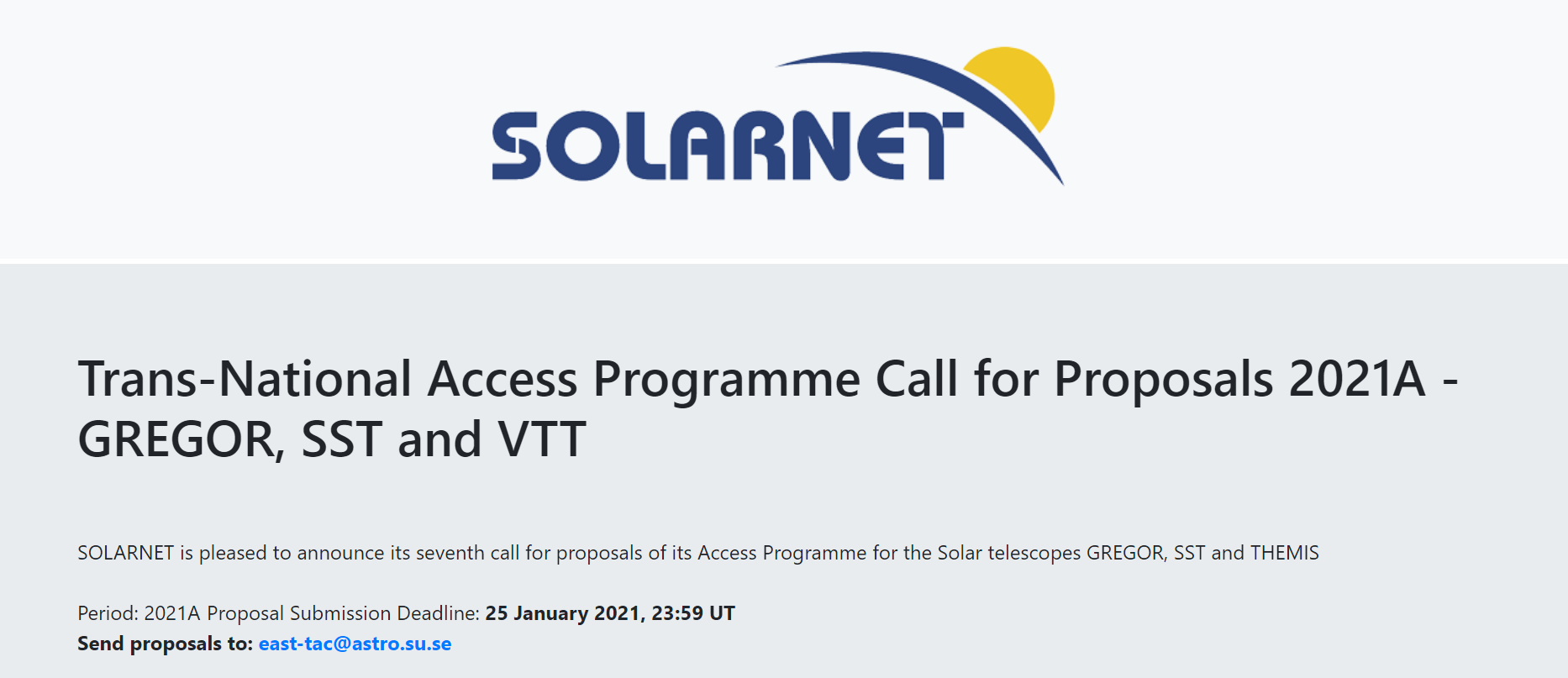Time and physical space are limited resources in a telescope. So, after selecting the scientific observations that will be executed, proposals get assigned to one of two different observing modes: visitor mode and service mode. In this article, we explain the differences between them.
 Announcement of the SOLARNET Trans-National Access Programme for different solar telescopes
Announcement of the SOLARNET Trans-National Access Programme for different solar telescopes
Observing time is a limited resource. With more than 600 solar astronomers scattered through Europe (plus those in the rest of the world who could also be interested in using EST), deciding which observing programmes will be carried out at the telescope is not an easy task.
Usually, some kind of Time Allocation Committee is set up to manage this process. Those committees issue competitive calls to which scientists submit their proposals. The proposals are then evaluated. The system varies according to the telescope, and one or various committees can participate in deciding the time allocation. For example, the calls issued by the Swedish 1-m Solar Telescope are split between various entities and committees, including the participant countries, the research institutes involved in its operation, and SOLARNET (whose proposals are ranked with the help of external referees). In the case of EST, the time allocation system is not yet decided.
Selecting proposals… and modes of observations
Selecting proposals is just the first step of the process. Usually, there are calls issued for different types of observations. And by that, we don’t (just) mean different types of scientific observations, but different types of “observational modes” in the telescope: visitor mode and service mode. A telescope can also be operated in a completely remote way but, although very common in space telescopes ―for obvious reasons―, this is not usual on the ground.
Visitor mode is what an external observer would call a “pure observing mode”: principal investigators and researchers travel to the telescope and stay and live there for a number of days while they perform their observations and experiments. Those stays tend to be short (between one and two weeks). There are several reasons for the short duration of the observing campaings, including that accommodation in a telescope is limited and expensive, and that the number of scientists who want to use the telescope is large.
Still, those days are greatly appreciated by scientists, who also get to discuss their results and ongoing investigations with other colleagues… Even though the time is more limited than it seems: “Solar observation is limited by seeing, which is very variable and difficult to predict [despite of the fact that telescopes are built in areas which outstanding seeing conditions]. Furthermore, some observations require certain situations and phenomena happening on the Sun in order for them to be correctly executed and worthy”, explains Dan Kiselman, from Stockholm University. “This means that maybe, out of those ten days, only a couple of days or hours yield useful results”, concludes Kiselman.
Service mode
Telescopes also offer a second mode of operation, called service mode. Less common than the visitor mode (not many telescopes have the capacity to offer it at all times), it is also greatly appreciated, since it allows researchers to follow the observations from their research institute, without the need to travel.
In service mode, the support astronomer in charge of operating the telescope gets a list of prioritised proposals that should be executed within certain settings and, according to the weather conditions and existence of solar targets, decides what should be done at each moment.
That is, the observations get executed not only attending to their science relevance, but also factoring in the current observational conditions. These executive decisions need to be made in real time, since solar and weather conditions can vary very quickly (that is the reason why support astronomers must have significant experience in observational solar physics).
Never idle
“Solar observation is a very dynamic activity”, reaffirms Dan Kiselman. The structures in the Sun are always changing, as are the atmospheric weather conditions.
On the one hand, that results in a very tight schedule for usable observations. On the other hand, this dynamism allows the telescope to be always working, even if the conditions are not suitable for scientific observations: “Solar telescopes and operators are always executing technical calibrations or testing instrumental sequences… all while being vigilant on the weather and solar conditions, so observations can be quickly resumed when the requirements are met”, concludes Kiselman.
